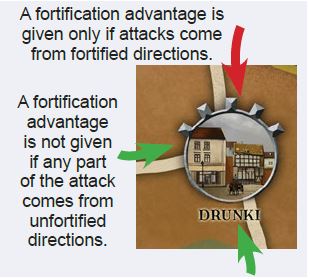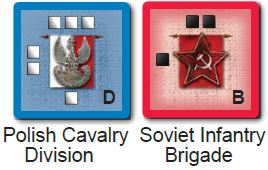
Map
The map portrays a portion of Eastern Europe in 1920. It is divided into areas that are named after local cities to simplify scenario setups. Along the outer edge of the map is a grid to help find areas during game setup. Each area name is followed by its grid location.

Each area can hold a maximum of four blocks (7.33). Areas are connected by roads and rails. Blocks travel from one area to the next via a road or a rail.
Rivers and woods do not affect the game in any way, but do give players a sense of how the geography affected area fortifications and road or rail connections.
Fronts
The map is divided into two fronts; the northern and the southern. The front line is designated by a yellow line that runs from east to west (A4-K4). In 4 player scenarios, each allied player commands blocks on one front only.

If a block of one player crosses the line between fronts, it moves to the control of his ally at the beginning of the next Operation Phase.
Fortifications
Some areas give defending blocks an advantage. These areas have a fortification symbol facing specific roads and rails.
Fortification Bonus: Defending blocks ignore one flanking penalty (7.34) and lose one less Strength Point (SP) during battle if attacked exclusively from fortified directions. No fortification bonus is applied unless ALL attacks come from fortified directions.

Key Cities

Areas with their names printed on a banner background are key cities and can support one garrison (3.0). A player controls a key city if a friendly garrison and/or one of his blocks occupies the city.
Controlled key cities are worth victory points (VPs), which are designated by a VP value within a yellow circle.
If a player holds a key city with no garrison in it, then moves all of his blocks off of it, the city becomes neutral (8.1). The player loses any VPs for the city and neither player may trace supply to it (7.7).
Supply Depots
A controlled key city acts as a Supply Depot if it is in-supply. The key city is in-supply if it has a clear path to Warsaw for the Poles or a Soviet Eastern Link for the Soviets. A "Clear Path" is defined as a path of any length that does not pass through areas that have enemy blocks or garrisons.
Soviet Eastern Links
Three key city areas on the eastern edge of the map represent links to the rest of Russia and are supply bases.

These areas, Yartsevo, Klintsy and Elizavetgrad, have rectangular banner backgrounds and are accessible to Soviet blocks only and may never be attacked. Soviet reinforcements arrive at these locations.
An unlimited number of blocks may be stacked in each Soviet Eastern Link area.
Note: National territories are color coded for player reference. Some countries have fixed borders, such as between the Free State of Prussia and Lithuania (D1). Other borders were contested and in constant flux.
This was especially true of the entire region between the Curzon Line (E2-F8), which the British had marked as the eastern border of Poland, and the western border of Russia.
This no-man's land, which stretches through the middle of the map from north to south (F4), was claimed by both countries.
Blocks
Blue blocks represent the Polish Alliance forces and red blocks represent the Soviet Alliance forces. Each block has squares depicted along its sides. Each square represents a Strength Point (SP).
A block is placed on the map with its current strength at the top of the block, facing the controlling player. As a block takes damage, it is rotated to a smaller value, corresponding to the number of SPs it lost. A 1SP block that takes a loss is destroyed and removed from the map.
 4SPs rotated to 3SPs |
There are two types of blocks in the game - infantry and cavalry.
- Infantry are depicted with black squares.
- Cavalry are depicted with white squares.
- Polish and Soviet allied infantry are depicted with green squares.
Note: Each square on a block edge represents either 1,500 cavalry (sabers) or 2,000 infantry (bayonets).
Infantry blocks - Move 1 area or force march up to 2 areas.
Cavalry blocks - Move 2 areas or force march up to 3 areas.
Divisions And Brigades
Blocks with up to 3SPs or 4SPs represent Divisions (D) and blocks with only 2SPs represent smaller volunteer, militia and detached Brigades (B).

Detachments
A player may split off up to two SPs from a Division block with a 'Move' or 'Forced March' order to create a new Brigade block(s). The combined SPs of the now weakened Division and the newly created Brigade will equal the Division's original strength before being split.
The newly created Brigade may not move during this Operation Phase.
A detachment may not be created if there are no Brigade blocks available in the Force Pool. Blocks may be combined during the Reinforcement Phase.
Garrison Counters

Each key city can support one garrison counter, which represents police and supporting units. Each garrison counter has a Polish and a Soviet side and is placed on a key city with the controlling player's side up.
Garrisons do not count towards block stacking limits, may never move, count as 1SP in battle, and are the first SP destroyed when taking combat losses.
Garrisons may be replaced at not cost during the Reinforcement Phase.
Order Counters
Each side has its own pool of order markers. The Polish players use the blue orders with the eagle on the back and the Soviet players use the red orders with the star on the back. Orders are given by all players at the beginning of each Operation Phase.

Reinforcement Cubes
Reinforcement cubes can be collected during each Operation Phase and are used to increase the strength of blocks or build new blocks during the Reinforcement Phase. Collected cubes are not hidden from other players.

- Black cubes: Polish or Soviet infantry reinforcements.
- White cubes: Polish or Soviet cavalry reinforcements.
- Green cubes: Polish or Soviet allied infantry reinforcements.
Track Sheet
The track sheet includes the Victory Points (VPs) Track, the Round Phase Track and the Initiative Track.
 Track Sheet |
The Round Phase Track marks the game's progression. Each round is divided into the Replenish Cards Phase, five identical Operation Phases, and a Reinforcement Phase.
The Initiative Track is divided into the Northern and Southern Front Initiative. It marks which player on each front has initiative.
Cards
A card may be played in one of six ways. A player will play a card for only one of its abilities.

-
A card may be played from a player's hand at the beginning of an Operation Phase to increase the number of orders a player can give during that phase.
-
A card may be played from a player's hand at the beginning of an Operation Phase to collect Reinforcement Cubes.
-
A card may be played from a player's hand at the beginning of an Operation Phase to resolve a Historical Event.
-
A card is always played during combat to modify a player's Combat Value. The card is either drawn blindly from the deck or played from the player's hand for a +1 combat modifier bonus.
-
A Battle Card may be played from a player's hand at the beginning Once played, cards are placed in the discard pile, except those of a battle to influence combat results.
-
A Reaction Card may be played from a player's hand in accordance with the card's description.
Once played, cards are placed in the discard pile, except those that specifically state that they are to be taken out of the game.
If a player goes to draw a card and is unable to do so because his draw pile is empty, the player immediately shuffles his discard pile to form a new draw deck.
Continue Reading
